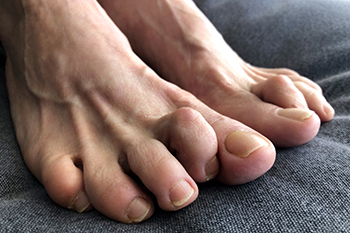6650 Frankford Ave
Philadelphia, PA 19135

If you notice that your toe does not lie flat, but instead has formed a peak in the middle, it is likely that you have developed a hammertoe. Although a hammertoe may be congenital, most develop over time. The main culprits in the latter case are arthritis and ill-fitting footwear. A hammertoe develops when the muscles weaken enough to cause an imbalance in the middle joint of the toe. The muscles tighten and the joint pops up, most often in the 2nd, 3rd, and 4th toe. Women are at higher risk of hammertoes, especially if they frequently wear high heels with pointed toes. These shoes can force the feet into a fixed, flexed position. Other causes include a toe that is stubbed, jammed, or broken. A hammertoe can become painful as the raised part of the joint rubs against the inside of a shoe. Proper footwear is the number one way to prevent a hammertoe. Diagnosis of the severity of a hammertoe will determine the treatment options available to you. Please consult with a podiatrist for an examination and an appropriate treatment plan.
Hammertoe
Hammertoes can be a painful condition to live with. For more information, contact John M. Fanelly, DPM from Northeast Philadelphia. Our doctor will answer any of your foot- and ankle-related questions.
Hammertoe is a foot deformity that affects the joints of the second, third, fourth, or fifth toes of your feet. It is a painful foot condition in which these toes curl and arch up, which can often lead to pain when wearing footwear.
Symptoms
Causes
Genetics – People who are genetically predisposed to hammertoe are often more susceptible
Arthritis – Because arthritis affects the joints in your toes, further deformities stemming from arthritis can occur
Trauma – Direct trauma to the toes could potentially lead to hammertoe
Ill-fitting shoes – Undue pressure on the front of the toes from ill-fitting shoes can potentially lead to the development of hammertoe
Treatment
Orthotics – Custom made inserts can be used to help relieve pressure placed on the toes and therefore relieve some of the pain associated with it
Medications – Oral medications such as anti-inflammatories or NSAIDs could be used to treat the pain and inflammation hammertoes causes. Injections of corticosteroids are also sometimes used
Surgery – In more severe cases where the hammertoes have become more rigid, foot surgery is a potential option
If you have any questions please contact our office located in Philadelphia, PA . We offer the newest diagnostic and treatment technologies for all your foot and ankle needs.